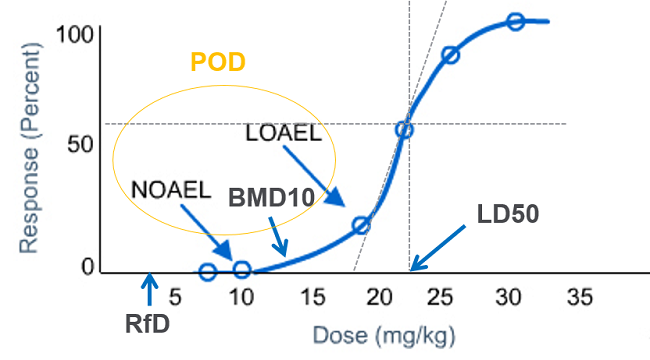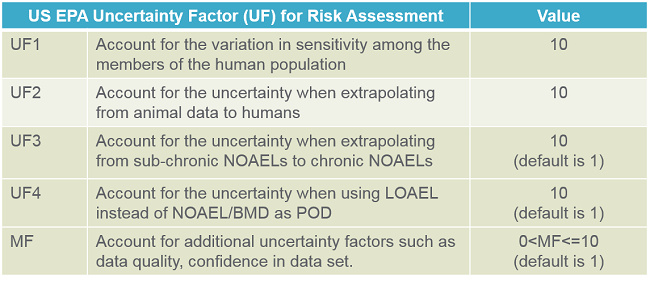What Is Point of Departure (POD) and How to Use It to Calculate Toxicological Reference Dose (RfD)
Little Pro on 2017-04-06
In toxicology, point of departure (POD) is defined as the point on a toxicological dose-response curve established from experimental data or observational data generally corresponding to an estimated low effect level or no effect level. It marks the beginning of extrapolation to toxicological reference dose RfD or reference concentration RfC.
US EPA defines RfD or RfC as follows. [Note: In EU, RfD may be called derived no-effect level (DNEL).]
-
Reference dose (RfD): An estimate (with uncertainty spanning perhaps an order of magnitude) of a daily oral or dermal exposure to the human population (including sensitive subgroups) that is likely to be without an appreciable risk of deleterious effects during a lifetime. Its unit is usually mg/kg bw/day or mg/kg.
-
Reference concentration (RfC): An estimate (with uncertainty spanning perhaps an order of magnitude) of a continuous inhalation exposure to the human population (including sensitive subgroups) that is likely to be without an appreciable risk of deleterious effects during a lifetime. Its unit is usually mg/L or ppm.
The most common POD used to derive RfD is no-observed-adverse-effect level (NOAEL), lowest-observed-adverse-effect level (LOAEL), or statistical benchmark dose (BMD). The picture below shows you the relationship between POD and RfD on a dose-response curve.

How to Use POD to Calculate RfD or RfC
RfD or RfC values can be calculated by dividing the point of departure (i.e, chronic NOAEL or BMD) with corresponding uncertainty factors (UF). When deriving acute reference dose (ARfD) is necessary, NOAEL from short-term or single dose toxicity studies shall be used. In case of multiple NOAELs for different effects and specifies, the lowest NOAEL value will be chosen as the point of departure. Sometimes, you have to modify the point of departure first before using the equation below.

Uncertainty factors and modifying factors are used to address the differences between the experimental data and the human situation, taking into account the following uncertainties in the extrapolation procedure.
- interspecies differences;
- intraspecies differences;
- differences in duration of exposure;
- issues related to dose-response;
- quality of whole database.
The table below summarizes standard uncertainty factors used by US EPA for risk assessment [Reference].

POD and RfD Example:
If 2 NOAEL values have been identified from long-term rat studies (10mg/kg bw/day for reproductive toxicity, 50mg/kg bw/day for dietary chronic toxicity), the point of departure (POD) will be 10mg/kg bw/day (the lowest NOAEL). The derived RfD for human health effects will be 0.1mg/kg bw/day (10mg/kg bw/day divided by 100). If human exposure level to a chemical substance by oral route is less than RfD 0.1mg/kg bw/day, the risk of the substance is acceptable.
When Is Modification of Point of Departure Necessary?
Modification of point of departure is necessary if there are any differences below between exposure routes and between experimental animals and humans.
- Differences in bioavailability (e.g., differences in absorption between routes and between experimental animals and humans).
- Differences in the units of exposures in case of route-to-route extrapolation (e.g, converting on oral NOAEL in mg/kg bw to inhalatory NOAEC in mg/m3).
- Differences in human and experimental exposure conditions (e.g. 6h/d for rat and 8h/d for workers).
- Differences in respiratory volumes between experimental animals (at rest) and humans (light activity).
It should be noted that modification is not appropriate in cases where the dose descriptor is based on human data or where human exposure is evaluated based on biological monitoring data.
Read more: How to Modify Dose Descriptors to A Correct Starting Point
Which POD Is Better: NOAEL or BMD?
Both NOAEL and benchmark dose BMD can be used as the point of departure to derive RfD in USA or DNEL is EU. The BMD approach is now EPA’s preferred approach and is fast becoming the world’s standard for dose-response analysis. The BMD approach has distinct advantages over the NOAEL approach in that the modeled benchmark dose (BMD05 or BMD10) reflects the shape of the dose–response curve and is less effected by the choice of experimental concentrations. However, the BMD approach requires a robust data set and additional knowledge of statistical modelling.
In our next tutorial, we will give you an introduction to the definition of benchmark dose and how to use EPA's benchmark dose software (BMDS) to calculate BMD05 and BMD10, which will later be used as the POD to derive RfD values.
Reference
- Reference Dose (RfD): Description and Use in Health Risk Assessments - US EPA
- Applications of Toxicogenomic Technologies to Predictive Toxicology and Risk Assessment
- Benchmark Dose Technical Guidance - US EPA
Having Questions?
We do not provide consultancy services. If you have questions or need any help, please contact our sponsor. You may also find an expert in CSP business directory below. If you are a consultant, you may get yourself listed in CSP business directory (free) or sponsor this page to leave your contact info on this page..
